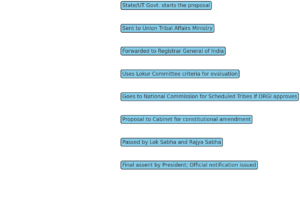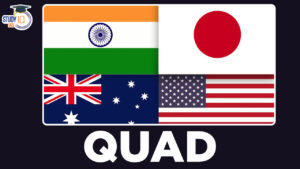Table of Contents
ST Status
Context: The Indigenous Tribal Leaders’ Forum (ITLF) and Zomi Council Steering Committee (ZCSC) are protesting against the government’s review of the Scheduled Tribe status for certain Kuki-Zo communities in India, fearing it will strip them of rights and exacerbate ethnic tensions.
Current procedure for inclusion of communities in Scheduled Tribes list

- State or Union Territory government initiates the inclusion proposal.
- The proposal is sent to the Union Tribal Affairs Ministry.
- The proposal is then sent to the Registrar General of India (ORGI).
- ORGI evaluates the proposal using the 1965 Lokur Committee criteria.
- If approved by ORGI, the proposal goes to the National Commission for Scheduled Tribes.
- With agreement from all institutions, the proposal goes to the Cabinet for an amendment to the Constitution (Scheduled Tribes) Order, 1950.
- After the amendment has been successfully passed by both Houses of Parliament, the Lok Sabha and the Rajya Sabha, the President’s office makes the final decision, issuing a notification as authorised by Articles 341 and 342.
We’re now on WhatsApp. Click to Join
Criteria For Inclusion
- Communities are specified as Scheduled Tribes based on:
- Primitive traits
- Distinctive culture
- Geographical isolation
- Shyness of contact with the wider community
- Backwardness
- Constitutional Silence, Established Practice: These criteria are not detailed in the Constitution but are recognized through consistent use.
- Historical Basis: The criteria consider historical documents such as the 1931 Census, reports from the Kalelkar Commission (1955), the Lokur Committee (1965), the Parliamentary Committee on SC/ST Orders (1967), and the Chanda Committee (1969).
Provisions For Scheduled tribes
Constitutional Provisions
- Article 366(25): Defines ‘Scheduled Tribes’ as those tribes or tribal communities or parts of groups identified within such tribes or communities as designated under Article 342 for the purposes of the Constitution.
- Article 342(1): Grants the President, after consultation with the Governor(s) of the state(s), the authority to specify tribes or tribal communities or parts of or groups within them as Scheduled Tribes in relation to that state or Union Territory.
- Fifth Schedule: Specifies the framework for the administration and control of Scheduled Areas and Tribes in all Indian states except Assam, Meghalaya, Tripura, and Mizoram.
- Sixth Schedule: Provides for the administration of tribal areas within the states of Assam, Meghalaya, Tripura, and Mizoram.
Legal Provisions
- Protection of Civil Rights Act, 1955: Safeguards against the propagation and practice of Untouchability amongst tribal groups.
- Scheduled Tribes (Prevention of Atrocities) Act, 1989: Protects tribal communities from discrimination and acts of atrocity based on caste.
- Panchayats (Extension to the Scheduled Areas) Act, 1996: Enhances self-governance for tribal populations by establishing political autonomy at the village (Gram Panchayat) level.
- Scheduled Tribes and Other Traditional Forest Dwellers (Recognition of Forest Rights) Act, 2006: Acknowledges the rights of local and tribal communities to minor forest produce.
Formation of fog
Context: In late December 2023 and early 2024, northern India faced severe winter conditions characterised by low temperatures and dense fog.
About Fog
- Fog is a thick cloud near the earth’s surface, dependent on lower temperatures and abundant surface moisture.
- Formation:
- Temperature and Dew Point: Fog forms when the air temperature cools to the dew point. The dew point is the temperature at which air becomes saturated with moisture and can no longer hold all of its water vapour.
- Cooling of Air: The cooling of air can occur in several ways. For instance, during the night, the Earth’s surface loses heat (radiational cooling), or warm air can move over a cooler surface (like a cold ocean current), leading to the cooling of the air above it.
- Condensation: When the air cools to the dew point, the water vapour in the air condenses into tiny water droplets. This condensation usually occurs around microscopic particles in the air, like dust, pollen, or pollution.
- Visibility: This fog and accompanying mist can significantly reduce visibility, sometimes to virtually zero.
Types Of Fog
- Radiation Fog:
- Occurs in the evening as the Earth’s surface, warmed during the day, radiates heat into the air.
- Water droplets form due to the heat transfer from the ground to the air.
- Commonly dissipates in the morning sun.
- In Delhi, according to the SAFAR forecasting system, this type of fog is prevalent.
- Advection Fog:
- Develops when warm, moist air moves over a cooler surface.
- The interaction between warm air and cooler surface air leads to condensation and fog formation.
- Typically seen where warm, tropical air encounters cooler ocean waters.
- Frontal or Precipitation Fog:
- This type of fog forms at the boundary where warm and cold air masses converge.
- The heavier cold air mass pushes the warm air mass underneath.
- Condensation of moisture in the warm air mass at this juncture results in fog, known as frontal or precipitation fog.
Suspension of news channel’s licence
Context: The Information and Broadcasting Ministry has suspended the licence of Marathi news channel Lokshahi for 30 days.
About The Suspension Of News Channel
- Who Suspends?: The Information and Broadcasting Ministry (I&B).
- The powers to regulate content rest only with the I&B Ministry based on the inputs from other ministries, as well as intelligence agencies.
- The I&B Ministry adopts emergency powers it has under the new IT Rules to block certain YouTube channels and social media accounts based on inputs from intelligence agencies.
- Previous Instances Of News Channel Licence Suspension:
- 2016: In November 2016, the Union government ordered that Hindi news channel NDTV India be banned for 24 hours for allegedly revealing sensitive information during a terror attack.
- 2018: The Union Government informed the parliament that 147 channels were cancelled during the last three calendar years, which includes the period leading up to 2018. This includes news channels like Al Jazeera English and NDTV Metro-nation, whose permissions were cancelled due to various reasons including denial of security clearance and non-operation.
- 2021: the government informed Rajya Sabha that in five years, 204 TV channels had ceased operations due to various reasons, including non-fulfilment of the conditions laid down in law. In the same period, the government had taken action in 128 cases related to alleged violations of the Programme Code by TV channels.
- 2022: The Union Government barred the telecast of the Malayalam news channel MediaOne citing “security reasons”.
Regulation
- Regulatory Framework: The Cable Television Networks (Regulation) Act 1995 governs television content in India.
- Central Government Control: This Act empowers the Central government to oversee the issuance of operating permissions for television channels and regulate their broadcast content.
- Registration Requirement: All channels must register with the government prior to broadcasting.
- Guidelines for Uplinking and Downlinking: The Ministry of Information and Broadcasting’s 2011 Guidelines detail the conditions for obtaining registration.
- Suspension Rights: The Central government can suspend a channel’s registration temporarily in the public interest or for national security reasons.
- Immediate Compliance: Channels must immediately comply with any government suspension order.
- Emergency Powers: In scenarios like war, calamities, or national security concerns, the government can prohibit the transmission of any channel.
- Renewal of Registration: Television companies are required to renew their registration every ten years.
- Renewal Denial: The government can refuse to renew registration if a company has breached the terms and conditions established by law.
Amaterasu
Context: Scientists recently detected the most powerful cosmic ray seen in more than three decades, which has been named ‘Amaterasu’.
About Amaterasu
- It’s among the highest-energy cosmic rays detected.
- Named after the Japanese sun goddess.
- Possesses energy over 240 exa-electron volts (EeV).
- Energy magnitude is millions of times greater than particles in the Large Hadron Collider.
- Comparable to a golf ball moving at 95 mph.
- Comparison with Oh-My-God Particle: Second only to the Oh-My-God particle, which was 320 EeV and detected in 1991.
- Origin: Believed to have originated from the Local Void, a space area near the Milky Way.
What Are Cosmic Rays?
- Origins and Nature:
- Cosmic rays are remnants of violent cosmic events.
- They consist of subatomic particles propelled through space at near light-speed.
- Composition: Composed of charged particles: protons, electrons, and atomic nuclei.
- Interaction with Earth:
- Upon hitting Earth’s atmosphere, they disrupt oxygen and nitrogen nuclei.
- This collision creates numerous secondary particles.
- Resulting Particle Shower: Secondary particles continue to collide and multiply, forming a vast shower that reaches the Earth’s surface.
Under new deal, each State can field tableau once in three years
Context: The Defence Ministry has proposed a rollover plan to give every State and Union Territory (UT) an opportunity to showcase their tableaux within a three-year cycle.
Process of Selection Of Tableaux For Republic Day
- The selection process is managed by the Ministry of Defence.
- Expert Committee Role: A committee of experts in fields like art, culture, and music, appointed by the MoD, shortlists the tableaux.
- Multiple Review Rounds: The committee conducts six to seven meetings to review and shortlist
- Initial Scrutiny: Initial sketches or designs of the tableaux are examined, with the committee suggesting possible modifications.
- Examination of 3D Models: Subsequently, three-dimensional models of the proposals are reviewed for final selection.
- Selection Criteria: Factors influencing the final selection include visual appeal, thematic representation, level of detail, accompanying music, and use of local resources.
Guidelines for Tableau Models and Performers
- Restriction on Writing/Logos: Use of logos or writing on tableaux is prohibited, except for the names of the representing states or Union Territories.
- Language for State Names: State names should be in Hindi at the front, in English at the back, and in the regional language on the sides.
- Limit on Performers: No more than 10 persons are allowed on the trailer, and performers must be from the state or UT they represent.
| Theme of Republic Day 2024 parade: ‘Viksit Bharat’ (Developed India) and ‘Bharat-Loktantra ki Matruka’ (India-Mother of Democracy). |


 Dalai Lama Confirms He will have a Succe...
Dalai Lama Confirms He will have a Succe...
 Transforming Remittances Landscape in In...
Transforming Remittances Landscape in In...
 QUAD Countries: Members, Objectives, Imp...
QUAD Countries: Members, Objectives, Imp...





















